Hilton Head Fishing Charters
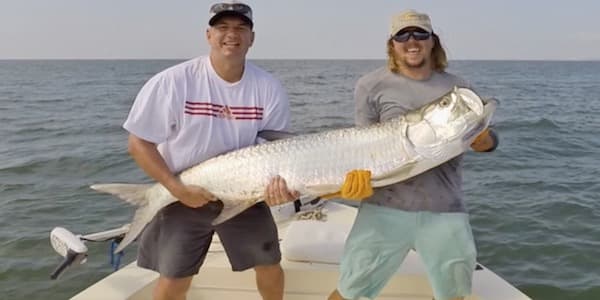
Light tackle fishing is the most exciting type of fishing around Hilton Head Island, no doubt about it! We offer a variety of charters depending on the seasons and what you’re interested in targeting. Our most popular trip is the half day (4 hours) which, depending on the time of year, provides the opportunity to target many different species. Light tackle charters take place around Hilton Head Island, Bluffton, and Beaufort’s pristine saltwater estuaries that are teeming with fish and wildlife. The Awesome Adventure Charters team has years of experience and are licensed and insured professionals.
Gamefish In Our Waters

Redfish
Year-round
REDFISH: Redfishing in Hilton Head Island is great for fly and light tackle anglers 12 months a year. Redfish use the nutrient-rich coastal marshlands of Hilton Head, SC as a nursery and typically stay around for 3-5 years, or until they grow 30+”. Redfish live in a number of interesting places which all require different fishing methods for a successful day on the water. During the Winter months, when the water is anywhere from the mid-60s down to the low 50s, the water is much more clear to the eye due to a lack of planktons and algae that require more sunlight and warmer temperatures to grow. When the waters around Hilton Head are cool and clear, sight casting the flats is at its prime. With schools up to 300+ redfish in size in only a foot or two of water, you can imagine the sight fishing is just unreal. These redfish will not always be in feeding mode as they use the shallows for warmth and protection from dolphins. When you do get the weather, tides, and fish cooperating at the same time you are likely to have a fishing day you will never forget. Spring and Summer months are also a blast when it comes to the flats. Rather than fishing the low tide mud flats during winter, the high tide spartina grass flats are the place to be to sight cast redfish. According to the moon phases, higher tides will flood the marshlands which are home to fiddler crabs. Redfish will cruise into areas so shallow that their backs may be above the surface as they slosh around sucking crabs from their burrows. As the redfish comb the bottoms of the flats, their golden tails break the surface and wave to you as if they are saying, “Hey, I’m over here. Cast right here.” Warmer months are also great for targeting redfish around structure such as docks, rocks/bulkheads, oyster bars, and grass points. Fall is the ultimate redfish season for light tackle and fly anglers. With large white shrimp in great numbers though out the marshes and rivers and the cooling water temperatures, redfish just plain gorge themselves. Fall is a great time to book a full day charter because redfish will begin schooling in good numbers on the low tide mud flats and still tail up on the high tide spartina grass flats. When anglers think of low country redfish and trout action, they typically think Sept-Dec. These are also great times to target redfish with artificial lures and flies such as gold spoons, Z-man soft plastics, Gulp Shrimp, and topwater plugs. Once a redfish outgrows the marsh, they are known as “bull reds” that live the rest of their lives in giant schools out in the ocean. These bull reds return to the sounds and rivers along Hilton Head, SC annually to spawn starting in September and can be successfully targeted through December. The bull red season provides action-packed, red hot fishing with redfish ranging from 15lbs to 35lbs! These are drag peeling bulldogging, head shaking, fighting machines on light tackle. Bull red fishing is typically a deeper water, cut bait style of fishing with some opportunities on the fly and artificial lures. For more information on bull reds

Cobia
May & June
Get Some
COBIA: The Spring cobia run here in Hilton Head Island makes for a very unique cobia fishing experience. These highly migratory fish enter the sounds on each side of Hilton Head Island in May and stay around through June. Port Royal Sound is the most important spawning grounds on the East coast and has very high concentrations of spawning fish. Cobia grows to about 100 pounds and average 20-40 pounds around Hilton Head. The larger of these fish, of course, is the females which carry bellies full of roe. Cobia is interesting looking, to say the least, like a cross between a catfish and a shark. Many (too many) value cobia as table fare and most end up being sold to restaurants around the island. These large brown predators are being over-harvested in our area and their population is dropping at an alarming rate. While some hunt cobia for meat, we hunt cobia for the thrill of hooking a 50 pounder on fly and light tackle only a few hundred yards from the marsh! As cobia overeat and get full, they approach the surface to utilize the warmer temperatures for digestion. When tides are slow and winds are calm, large cobia can be seen quite a ways away as they send out their own wake across the surface, like a small brown submarine. Cobia are not the smartest fish in our waters so as long as your offering is in sight of a surface cobia, you have a pretty good chance at a hook-up. Medium-heavy spinning gear loaded with 30lb braided line and 10-12wt fly rods are my go-to for inshore cobia sight casting. Large eel imitations and large saltwater plugs are often eaten at first glance. Live bait, of course, is almost a done deal if placed in front of a curious cobia. Brightly colored flies that imitate eels and large baitfish work well in white, green, orange, and red. This fishery is very seasonal so mark your calendar and let's go sight cast a huge cobia!
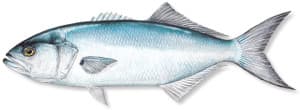
Bluefish
Spring, Summer, & Fall
BLUEFISH: Bluefish are a lot of fun to catch whether your a little kid, or an elite fly fisherman. The bluefish around Hilton Head, SC average 1-6lbs and are not hard to entice. Silver spoons, shiny flies, and even live bait can get you hooked up to some bluefish. When bluefish are traveling in large schools, it can be very productive to drift around the school and cast lures and flies into tidal rips and around sandbars or other structure. Small bluefish make great bait for other predatory fish such as cobia, bull redfish, tarpon, and sharks. Loading up the bait well with little “snapper blues” on light tackle and using them as bait for the more challenging target species is a lot of fun! Come on and lets catch em’ up!

Sheepshead
Year Round
SHEEPSHEAD: A great tasting fish that frequents old dock pilings and rock walls. Toss a live fiddler crab to these big saltwater panfish and get ready to set the hook!
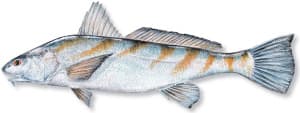
Whiting
Year Round
WHITING: These smaller fish are great for kids and adults alike. “Critter fishing” at its finest with fish ranging from 10″-15”
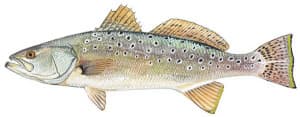
Sea Trout
Spring, Summer, & Fall
SEA TROUT: Speckled sea trout make a great light tackle target species here in the Low Country. Trout can be found almost all year round but are most predictable during the fall when the shrimp are in abundance. Starting in the Spring we will see trout along the oyster bars and grass points with very little pattern to their whereabouts. The action picks up through the Summer as trout follow white shrimp into the ocean where they can be targeted on structure such as our nearshore artificial reefs. Many of the trout will stay in the estuaries all the way through Winter. Fall is by far the very best speckled sea trout fishing Hilton Head Island has to offer. With shrimp marching inshore and mega schools of mullet migrating south, these trout will become much more predictable bringing us some fantastic light tackle action through the new year! With most trout ranging from 1/2lb to 4lbs around Hilton Head and Beaufort, medium-light action spinning rods and a 10lb line is recommended. Typical trout tactics include soft plastics, plugs, spoons and of course live shrimp, mud minnows and finger mullet. There’s nothing quite like a big gator sea trout thrashing its head at the surface as you crank in yet another. If you're looking for a species that behaves and takes artificial lures like largemouth bass, this is it!

Tarpon
July Through October
TARPON: Tarpon Fishing here around Hilton Head is the ultimate light tackle fishing! These highly migratory brutes arrive as early as June and stay until the water cools in October. Tarpon are not the easiest fish in our waters to target and they sure aren’t the easiest fish to catch, but when the tarpon bite is on, IT’S ON! Tarpon around Hilton Head average 75-100lbs and put on quite an aerial show once they are hooked. Just imagine your rod bows all the way over in the rod holder as a 6ft silver giant leaps out of the water in a head-shaking panic, peeling off 100 yards of line! Most of our tarpon come from the mouth of the Port Royal and Calibogue Sounds and along the beachside where sandbars and deeper holes hold large concentrations of baitfish. That being said, we catch our share of tarpon up rivers and along the marshes in as little as 4 feet of water. Gearing up for tarpon is critical to success. Tarpon make short work of cheap reels, dull hooks, old line, bad knots, and even good knots! Keeping a tarpon hooked all the way to the boat takes a premium tackle, premium hooks, and of course a determined angler. Heavy action St. Croix spinning rods with Penn Conflict 6000 reels are my weapon of choice when targeting the silver king. The 50-65lb braided line may seem like overkill but you’ll be glad you geared up when your fish of a lifetime (literally) breaks the surface like a giant silver explosion. Smaller fish can be boated within 15 minutes while the 100+lb fish may take up to an hour. One thing is for sure, once you get a taste of tarpon fishing, you’ll be hooked for life!

Ladyfish
Summer & fall
LADYFISH: The poor man’s tarpon! These slender beauties make fast runs with impressive aerial antics! What a fun fish to throw artificial lures and flies at all summer long!
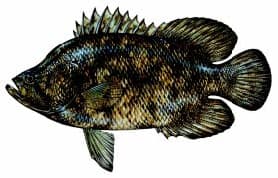
Tripple Tail
Summer
TRIPPLE TAIL: Triple tail fishing in Hilton Head Island is exciting, when you can find them. During the Spring, Summer, and Fall, triple tail migrate into the sounds and creeks and hide out underneath or beside structure and floating debris. More times than not, triple tail look like a paper bags floating in the water and are tough to distinguish in cloudy water. Triple tail think they are masters of disguise but they often present great sight casting opportunities for fly and spinning anglers. Big Spring tides that wash large mats of spartina grass out of the marshes are most productive for sight fishing triple tail. Otherwise, it pays to keep an eye out for suspicious blobs under the surface while traveling from fishing spot to fishing spot. Awesome Adventure Charters strongly encourages catch and release however, a big triple tail is a tough fish to throw back. Yum!
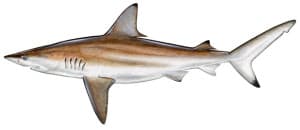
Sharks
Year Round
SHARKS: The inshore waters of the Lowcountry are loaded with sharks (28 different species) ranging from 12 inches to 12 feet! You can always count on an encounter from one of these toothy critters between May and November
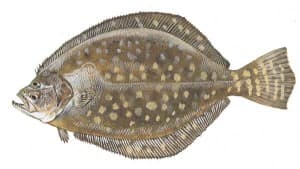
Flouder
Summer & Fall
FLOUNDER: Flounder can be caught from Spring-Fall around Hilton Head Island before they migrate offshore to wrecks and reefs for Winter. These flat fish are bottom dwellers and sit buried to the bottom facing up current, waiting on their prey to pass overtop for the ambush. Flounder feed on shrimp and fish and are somewhat challenging to target with traditional rod and reel. Most of our flounder bites come as by-catch while redfishing and trout fishing. The initial bite from a flounder can be very subtle and feel as if you are snagged on the bottom. Once you pull on that snag a bit, the flounder will peel off the bottom and put up a little bit of a fight. Live shrimp, finger mullet, and mud minnows fished on a jig head or Carolina rigged on the bottom are great choices when it comes to flounder fishing here in Hilton Head. When it comes to artificial baits, Berkley Gulp and Z-man soft plastics fished slow and low will get the job done. Flounder can also be taken on fly gear by blind casting around oyster bars and creek mouths. Clousers, EP minnows, and shrimp patterns seem to work best for flounder on the fly. Awesome Adventure Charters encourages catch in release for most inshore species but sometimes a big ol’ flounder is hard to resist. Yum!

Spanish Mackerel
Spring, Summer, & Fall
SPANISH MACKEREL: Spanish Mackerel a blast on light tackle and fly rods! These Atlantic predators arrive April and are available through October. Spanish mackerel can be caught in the Port Royal Sound, Calibogue Sound, and on nearshore wrecks in the ocean. The larger Mackerel in the 5-pound range tend to stay in the ocean whereas the smaller 2 and 3 pounders migrate towards the marshlands. These are vicious predators with big appetites and a mouth full of little razor sharp teeth. Spanish mackerel feed almost constantly on small squid, anchovy minnows, and menhaden. It is not uncommon to retrieve a live bait that is cut clean in half by mackerel. There are many ways to catch Spanish mackerel here around Hilton Head Island. The most interactive approach is to follow diving birds and blitzing baitfish. When the birds are working the bait, the mackerel are often underneath in a feeding frenzy. Casting spoons, gotcha plugs, and flies into these baitfish blitzes can be very productive. Another method we do very well with is live baiting over artificial reefs. With enough chumming, mackerel can be enticed to attack surface baits and put on quite a show! These green bullets are a great fight on light tackle and flyrods, but be sure your reels are loaded with line, because these fish pull!
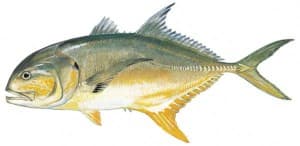
Jack Crevalle
Summer & Early Fall
JACK CREVALLE: It doesn’t get much more exciting than jack crevalle fishing in Hilton Head! Large schools of adult jack crevalle swim into Port Royal Sound, Calibogue Sound, and off the beaches starting in May and will stay around until around October when the water cools. These fish range from 20-40lbs of pure muscle and are sure to break a sweat on even the most experienced anglers. These schools swim the surface in calm conditions and are noticeable to the trained eye. Sometimes you will see what looks like a river moving through a calm slick of water and sometimes only an inch or two of their yellow, sickle-shaped tail fins are visible above the water. Once you locate these monster jacks, you have a variety of offerings they are likely to explode on. Many favor large offshore poppers and lipless crank baits because these baits are large, noisy, bright, and they just plain get eaten! The ultimate way to catch a giant jack crevalle is on a big popper fly. There is just nothing like watching a dozen jacks break away from the school and compete for your fly in a fast, splashing yellow blur! Once you hook up on an adult jack crevalle, you’d better clear your schedule because these brutes will peel 100 yards of line on their first run and then sound down to the bottom for as long as they can stand. My tackle of choice for giant jacks are the same spinning rods as I use for tarpon, St. Croix Tidemaster Heavy 8 footers with 6000 size reels full of 50lb braided line. These rods launch plugs accurately and have the backbone to break a jack crevalle’s spirit. For fly gear I use 10-12wt Sage xi3 rods loaded with Rio floating tarpon lines. These larger rods and lines will help get the extra distance casting those larger poppers or streamers, and you’ll be glad you brought the 12wt once you hook one! Getting these fish unhooked and back into the water quickly is critical to the fish’s survival, because a large jack crevalle on light enough tackle can literally fight themselves to death. Don’t miss your chance at a fish of a lifetime, let’s go get one!
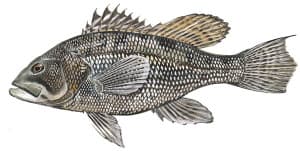
Black Sea Bass
Year Round
BLACK SEA BASS: BSB is smaller offshore fish that readily eat jigs and other lures on the nearshore artificial reefs. These Sea Bass are about as tasty as they come!

King Mackerel
Summer
KING MACKEREL: King Mackerel are fast swimming, high jumping, drag screaming machines! Hilton Head Island is not a big king mackerel destination but does provide some opportunity for trolling and light tackle enthusiasts. You are not likely to troll for anything with Awesome Adventure Charters so live baiting and live chumming is the name of the game. When king mackerel are present, it's important to have plenty of live menhaden and plenty of patience. The most exciting time to hook king mackerel is while fishing for Spanish mackerel on light tackle. These kings certainly stand out from the Spanish mackerel with their acrobatics and blistering high speed runs.